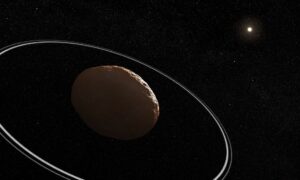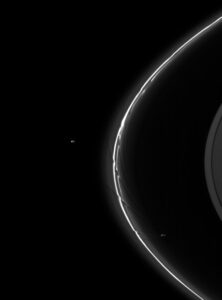
In school, we learn all about the eight planets, Pluto, the asteroid belt – and its larger members like OG former planet Ceres – and comets. What your average kids’ book omits are the random larger objects that hang out in the middle distances in our solar system. Around Jupiter’s orbit, we have the Trojan asteroids, and out around between Jupiter and Neptune are transition objects called centaurs. Like asteroids, they can be a couple hundred kilometers across, but unlike most asteroids, they seem to be primarily made of ice that can cause tails or other outbursts like we normally associate with comets.
Among the centaurs of our solar system orbiting between Saturn and Uranus is a 250-km across object known as Chariklo wearing a pair of rings. These gossamer strands of material were discovered in 2013 when Charilko and its rings were observed passing in front of a star. Researchers watching this event saw the star’s light getting blocked by Charilko but also saw a pair of dips that could only be explained by rings.

Since then, the rings have been confirmed during subsequent occultations, and now, researchers are left with a really cool discovery that is really hard to explain. In general, rings will spread out over time, but these rings are narrow. To try and understand how this is possible, researchers Amanda Sickafoose and Mark C Lewis ran a series of computer simulations that included rings with a variety of parameters as well as the inclusion of a possible moon — if “moon” is the right word for a blob of ice and rock orbiting a bigger rock ice thing. They found that simulations with only the centaur Charilko and its rings couldn’t maintain the narrow structures we see, but the addition of a three-kilometer companion would make this system stable. This size of an object is too small to see with current technology, but one day, maybe a mission to the outer solar system or significantly larger telescopes will make it possible to see if this paper’s predictions are true.
This work appears in The Planetary Science Journal.
